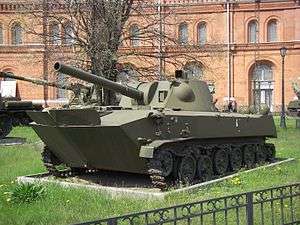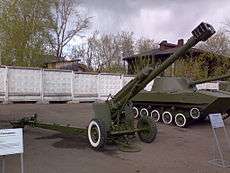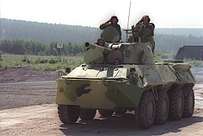2S9 Nona
The 2S9 NONA (Новейшее Орудие Наземной Артилерии - Newest Ordnance of Ground Artillery) is an extremely light-weight self-propelled and air-droppable 120 mm gun-mortar designed in the Soviet Union, which entered service in 1981. The 2S9 chassis is designated the S-120 and based on the aluminium hull of the BTR-D airborne multi-purpose tracked armoured personnel carrier. More generally, the 120 mm mortar is referred to as the Nona, with the 2S9 also known as the Nona-S. A BTR-80 based version is the 2S23 or Nona-SVK and the towed 2B16 version is named the Nona-K. Although no figures have been released, it is estimated that well over 1,000 2S9 were built.[2]
| 2S9 Nona | |
|---|---|
 2S9 in Saint-Petersburg Artillery museum | |
| Type | Self-propelled air-droppable mortar |
| Place of origin | Soviet Union |
| Service history | |
| In service | 1981 – present |
| Used by | see Operators |
| Wars | Syrian Civil War War in Donbass Russo-Georgian War |
| Production history | |
| Designer | TSNIITOCHMASH |
| Designed | 1974-1980 |
| Manufacturer | Motovilikha Plants |
| Produced | 1979 – 1989 |
| Specifications | |
| Mass | 8.7 tonnes |
| Length | 6.02 m |
| Barrel length | approx. 1.8 m [1] |
| Width | 2.63 m |
| Height | 2.3 m |
| Crew | 4 |
| Caliber | 120 mm |
| Elevation | -4 to +80 degrees |
| Traverse | 70 degrees |
| Rate of fire | 10 rpm, max; 4 rpm, sustained |
| Effective firing range | 8.8 km (conventional); 12.8 km (extended) |
| Armor | 15 mm max |
Main armament | 120 mm 2A60 mortar |
Secondary armament | 7.62 mm machine gun |
| Engine | 5D20 Diesel 240 hp |
| Power/weight | 27.1 hp/tonne |
| Payload capacity | 40-60 rounds |
| Suspension | torsion |
| Ground clearance | 450 mm |
| Fuel capacity | 400 liters |
Operational range | 500 km |
| Maximum speed | 60 km/h (road); 9 km/h (water) |
Description
The 2S9 Nona-S is an amphibious vehicle that can be propelled through the water by two rear water-jets. It is operated by a four-man crew comprising a commander, a driver/mechanic, a gunner, and a loader. The hull interior is separated into a command compartment, a fighting compartment and an engine compartment. A welded steel turret is located at the middle of the hull. The two-man turret has hatches for the gunner and loader respectively.
The 2S9 utilizes a 120 mm 2A51 (later 2A60) mortar with a 1.8-meter-long barrel. It is breech-loaded and capable of firing HE (high explosive), white phosphorus and smoke rounds, as well as laser-guided munitions like KM-8 Gran.[3][1]
Current operators












External links
- "2S9 Anona (Anemone)- 120mm SPH/Mortar". GlobalSecurity.org. Archived from the original on 12 June 2008. Retrieved 10 May 2008.
- Walkaround 2S9 Nona from Kremenchug
| Wikimedia Commons has media related to 2S9 Nona. |
See also
- 2S31 Vena tracked 120mm mortar system (2A80)
References
- International Institute for Strategic Studies (February 2016). The Military Balance 2016. 116. Routlegde. ISBN 9781857438352.
- Marat Kenzhetaev (1998). "Self Propelled Artillery and Mortars". www.armscontrol.ru. MIPT Center for Arms Control, Energy and Environmental Studies. Archived from the original on 10 January 2010. Retrieved 3 May 2010.
- Jane's Armour and Artillery 1997-98 ISBN 0-7106-1542-6
- "The Russian BMD-1 Infantry Fighting Vehicle - TankNutDave.com". Archived from the original on 9 October 2018.
- The Military Balance 2016, p. 180.
- The Military Balance 2016, p. 182.
- The Military Balance 2016, p. 185.
- Small Arms Survey (2012). "Blue Skies and Dark Clouds: Kazakhstan and Small Arms". Small Arms Survey 2012: Moving Targets. Cambridge University Press. p. 131. ISBN 978-0-521-19714-4. Archived from the original (PDF) on 31 August 2018. Retrieved 30 August 2018.
- The Military Balance 2016, p. 187.
- The Military Balance 2016, p. 188.
- The Military Balance 2016, pp. 190-200.
- "Syria Rearms". Archived from the original on 20 June 2017. Retrieved 15 June 2017.
- The Military Balance 2016, p. 203.
- The Military Balance 2016, pp. 205-206.
- Ferguson, Jonathan; Jenzen-Jones, N.R. (November 2014). Raising Red Flags: An Examination of Arms & Munitions in the Ongoing Conflict in Ukraine, 2014. Research Report 3. Armament Research Services. pp. 50, 70. ISBN 978-0-9924624-3-7. Archived from the original on 25 September 2018. Retrieved 17 March 2019.
- The Military Balance 2016, p. 491.
- The Military Balance 2016, p. 208.
- "Trade Registers". Armstrade.sipri.org. Archived from the original on 14 April 2010. Retrieved 20 March 2017.
- The Military Balance 2016, p. 416.


